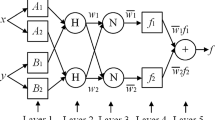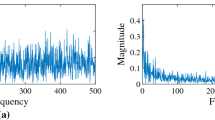Abstract
Effectiveness of online bearing status monitoring (OBSM) depends deeply on the online data processing ability and the sensitivity of data features used to recognize the mechanical-system dynamic response change. Focusing on these, we present a novel method of OBSM based on singular spectrum analysis (SSA) and adaptive neuro-fuzzy inference system (ANFIS) with the highlights as follows. A sensitive and stable multi-feature is discovered to better the ability to distill the valuable information in noisy and massive databases (NMDs) and process impulse-noise in them. The SSA-based high-frequency noise removal solution, the ANFIS’ interpolating and identifying capability, and the dual function of the proposed multi-feature are combined in a new algorithm named AfOBSM for building a system of OBSM through two phases, offline and online. The offline is to identify the mechanical-system in the presence of the typical kinds of bearing faults. The ANFIS is trained in this phase using a training dataset. Meanwhile, the online is to estimate online the real status of the bearing(s) based on the trained ANFIS and a monitoring dataset. Surveys from an experimental-system were performed. The obtained results showed the positive effects of the AfOBSM.
Similar content being viewed by others
References
X. Yin and S. Lafortune, “On the decidability and complexity of diagnosability for labeled Petri nets,” IEEE Trans. on Auto. Control, vol. 62, no. 11, pp. 5931–5938, 2017.
X. Yin, J. Chen, Z. Li, and S. Li, “Codiagnosability analysis of bounded Petri nets,” IEEE Trans. on Auto. Control, vol. 63, no. 4, pp. 1192–1199, 2018.
X. Yin, J. Chen, Z. Li, and S. Li, “Robust fault diagnosis of stochastic discrete event systems,” IEEE Trans. on Auto. Control, vol. 64, no. 10, pp. 4237–4244, 2019.
L. Liu, Y. J. Liu, and S. Tong, “Neural networks-based adaptive finite-time fault-tolerant control for a class of strict-feedback switched nonlinear systems,” IEEE Trans. on Cyb., vol. 49, no. 7, pp. 2536–2545, 2019.
X. Xie, D. Yue, and J. H. Park, “Observer-based fault estimation for discrete-time nonlinear systems and its application: A weighted switching approach,” IEEE Transactions on Circuits and Systems — I: Regular Papers, vol. 66, no. 11, pp. 4377–4387, 2019.
T. Boukra, “Identifying new prognostic features for remaining useful life prediction using particle filtering and neuro-fuzzy system predictor,” Proc. of IEEE 15th Inter. Conf. on Envir. and Elect. Eng., Rome, Italy, 2015.
L. Yaguo, J. Feng, L. Jing, X. Saibo, and X. D. Steven, “An intelligent fault diagnosis method using unsupervised feature learning towards mechanical big data,” IEEE Trans. on Ind. Electro., vol. 63, no. 5, pp. 3137–3147, 2016.
Q. T. Tran, S. D. Nguyen, and T. I. Seo, “Algorithm for estimating online bearing fault upon the ability to extract meaningful information from big data of intelligent structures,” IEEE Trans on Industrial Electro., vol. 66, no. 5, pp. 3804–3813, 2019.
V. S. Jigajinni and V. Upendranath, “ANFIS-based fault diagnosis tool for a typical small aircraft fuel system,” Proc. of Inter. Conf. on Intelli. Comm., Control and Devices. Advances in Intelli. Systems and Computing, Springer, Singapore, pp. 391–405, 2017.
A. K. Mahamad and T. Hiyama, “Fault classification based artificial intelligent methods of induction motor bearing,” Int. J. Innov. Comput., Inf. Control, vol. 7, no. 9, pp. 5477–5494, 2011.
Z. Tong, W. Li, B. Zhang, F. Jiang, and G. Zhou, “Online bearing fault diagnosis based on a novel multiple data streams transmission scheme,” IEEE Access, vol. 7, pp. 66644–66654, 2019.
J. Chebil, M. Hrairi, and N. Abushikhah, “Signal analysis of vibration measurements for condition monitoring of bearings,” Australian J. Basic Appl. Sci., vol. 5, no. 1, pp. 70–78, 2011.
S. D. Wu, C. W. Wu, T. Y. Wu, and C. C. Wang, “Multiscale analysis based ball bearing defect diagnostics using Mahalanobis distance and support vector machine,” Entropy, vol. 15, no. 2, pp. 416–433, 2013.
J. F. Zhang and Z. C. Huang, “Kernel Fisher discriminant analysis for bearing fault diagnosis,” Proc. of Inter. IEEE Conf. on Machine Learning and Cybernetics, Guangzhou, China, pp. 3216–3220, 2005.
W. Sun, G. Yang, Q. Chen, A. Palazoglu, and K. Feng, “Fault diagnosis of rolling bearing based on wavelet transform and envelope spectrum correlation,” J. Vib. and Control, vol. 19, no. 6, pp. 924–941, 2013.
B. Sreejith, A. Verma, and A. Srividya, “Fault diagnosis of rolling element bearing using time-domain features and neural networks,” Proc. of The 3rd Inter. IEEE Conf. on Ind. and Infor. Sys., India, 2008.
W. Q. Wang, M. F. Golnaraghi, and F. Ismail, “Prognosis of machine health condition using neuro-fuzzy systems,” Mech. Sys. and Sig. Pro., vol. 18, pp. 813–831, 2004.
I. K. Jeong, M. Kang, J. Kim, J. M. Kim, J. M. Ha, and B. K. Choi, “Enhanced DET-based fault signature analysis for reliable diagnosis of single and multiple-combined bearing defects,” Shock and Vibration, Article ID 814650, 10 pages, 2016.
S. D. Nguyen, K. N. Ngo, Q. T. Tran, and S. B. Choi, “A new method for beam-damage-diagnosis using adaptive fuzzy neural structure and wavelet analysis,” Mech. Sys. and Signal Pro., vol. 39, pp. 181–194, 2013.
D. R. Salgado and F. J. Alonso, “Tool wear detection in turning operations using singular spectrum analysis,” J. of Mate. Proc. Tech., vol. 171, pp. 451–458, 2006.
B. Kilundu, P. Dehombreux, and X. Chiementin, “Tool wear monitoring by machine learning techniques and singular spectrum analysis,” Mech. Sys. and Sig. Proc., vol. 25, pp. 400–415, 2011.
N. Golyandina and Z. Nekrutkin, Analysis of Time Series Structure — SSA and Related Techniques, Chapman & Hall/CRC, Boca Raton, Florida, 2001.
T. Liu, J. Chen, and G. Dong, “Singular spectrum analysis and continuous hidden Markov model for rolling element bearing fault diagnosis,” J. of Vib. and Control, vol. 21, no. 8, pp. 1506–1521, 2015.
S. D. Nguyen, S. B. Choi, and T. I. Seo, “Recurrent mechanism and impulse noise filter for establishing ANFIS,” IEEE Trans. on Fuzzy Systems, vol. 26, no. 2, pp. 985–997, 2018.
S. D. Nguyen, Q. H. Nguyen, and T. I. Seo, “ANFIS deriving from jointed input-output data space and applying in smart-damper identification,” Applied Soft Computing, vol 53, pp. 45–60, 2017.
S. D. Nguyen and T. I. Seo, “Establishing ANFIS and the use for predicting sliding control of active railway suspension systems subjected to uncertainties and disturbances,” Inter. J. of Mach. Learning and Cybernetics, vol. 9, pp. 853–865, 2018.
S. D. Nguyen, H. D. Vo, and T. I. Seo, “Nonlinear adaptive control based on fuzzy sliding mode technique and fuzzy-based compensator,” ISA Transactions, vol. 70, pp. 309–321, 2017.
S. D. Nguyen and K. N. Ngo, “An adaptive input data space parting solution to the synthesis of neuro-fuzzy models,” Int. J. of Control, Automation, and Systems, vol. 6, no. 6, pp. 928–938, 2008.
S. D. Nguyen, S. B. Choi, and T. I. Seo, “Adaptive fuzzy sliding control enhanced by compensation for explicitly unidentified aspects,” Int. J. of Control, Auto. and Sys., vol. 15, pp. 2906–2920, 2017.
C. Chen, B. Zhang, G. Vachtsevanos, and M. Orchard, “Machine condition prediction based on adaptive neuro-fuzzy and high-order particle filtering,” IEEE Tran. on Ind. Elec., vol. 58, no. 9, pp. 4353–4364, 2011.
A. Ali, “Impulse noise reduction in audio signal through multi-stage technique,” Eng. Science and Tech., an Inter. J, vol. 22, pp. 629–636, 2019.
F. Ramsey, “Understanding the basis of the Kalman Filter via a simple and intuitive derivation,” IEEE Signal Pro. Mag., vol. 128, pp. 1–5, 2012.
W. Greg and B. Gary, An Introduction to the Kalman Filter, UNC-Chapel Hill, TR 95–041, 2016.
S. D. Nguyen, S.-B. Choi, and J.-H. Kim, “Smart dampers-based vibration control — Part 1: Measurement data processing,” Mech. System and Signal Pro., 2020. DOI: https://doi.org/10.1016/j.ymssp.2020.106958
K. Cengiz, K. Cem, and T. Önsen, “A weighted mean filter with spatial-bias elimination for impulse noise removal,” Dig. Sig. Pro., vol. 46, pp. 164–174, 2015.
P. H. Lin, B. H. Chen, S. C. Cheng, and S. C. Huang, “A morphological mean filter for impulse noise removal,” IEEE/OSA J of Display Technology, vol. 12, no. 4, pp. 344–350, 2016.
A. W. Benjamin, O. B. Kwame, and T. A. Sampson, “Efficient novel vector median filter design for impulse noise suppression in color images,” Int.t J. of Inno. Comp. Infor. and Cont., vol. 13, no. 6, pp. 1349–4198, 2017.
C. Spinola and A. Gago, “Filtering of impulse noise from twin laser sensor signals in the process of non-contact thickness measurement in a stainless steel sheet production line,” IEEE Instr. and Mea. Tech. Conf., Baltimore, MD, USA, pp 1–4, 2000.
L. Zhang, Y. Zhu, and W. X. Zheng, “Synchronization and state estimation of a class of hierarchical hybrid neural networks with time-varying delays,” IEEE Trans. on Neu. Net. and Learning Systems, vol. 27, no. 2, pp. 459–470, 2016.
W. Gong and Z. Cai, “Differential evolution with ranking-based mutation operators,” IEEE Trans. on Cybern., vol. 43, pp. 1–16, 2013.
Author information
Authors and Affiliations
Corresponding author
Additional information
Recommended by Associate Editor Xiao-Heng Chang under the direction of Editor Guang-Hong Yang.
The authors are very grateful to the reviewers for their useful comments and suggestions. This research is funded by Vietnam National Foundation for Science and Technology Development (NAFOSTED) under grant number 107.01-2019.328.
Nang Toan Truong received his master’s degree in automation engineering from Ho Chi Minh City University of Transport (UT-HCMC) in 2011. Currently, he is a Ph.D. student at Institute for Computational Science (INCOS), Ton Duc Thang University, TDTU. Also, he is a lecturer at Industrial University of Ho Chi Minh City (IUH), Vietnam. His research interests include artificial intelligence and its applications to nonlinear control, data mining, system identification, and structures’ health managing.
Tae-Il Seo received his Ph.D. Degree in mechanical engineering from Ecole Centrale de Nantes, France, in 1998. From 1998 to 1999, he was a postdoctoral research fellow in the Department of Mechanical Engineering in Inha University, Incheon, Korea. From 1999 to 2001, he was a research fellow in the Department of mechanical corporation Laboratory, Inha University of Korea. From 2001 to 2003, he was a researcher in the Department of Precision Mold Lab, KITECH (Korea Institute of Industrial Technology), Korea. Currently, he is a Professor in the Department of Mechanical Engineering at Incheon National University, Korea. Dr. Seo’s current research interests include micro end-milling, intelligent manufacturing system, CAD/CAD systems, etc.
Sy Dzung Nguyen received his M.E. degree in manufacturing engineering from Ho Chi Minh City University of Technology (HCMUT) — VNU in 2001 and a Ph.D. degree in applied mechanics in 2011 from HCMUT. He is an Assoc. Professor at Institute for Computational Science (INCOS), Ton Duc Thang University, Ho Chi Minh City, Vietnam. He is currently the Head of Division of Computational Mechatronics (DCME), INCOS. He was a postdoctoral fellow at Inha University, Korea in 2011–2013, at Incheon National University, Korea in 2015–2016. His research interests include artificial intelligence and its applications to nonlinear adaptive control, system identification and managing structure damage. Dr. Nguyen has been the main author of plenty of ISI papers in these fields.
Publisher’s Note
Springer Nature remains neutral with regard to jurisdictional claims in published maps and institutional affiliations.
Rights and permissions
About this article
Cite this article
Truong, N.T., Seo, TI. & Nguyen, S.D. Bearing Fault Online Identification Based on ANFIS. Int. J. Control Autom. Syst. 19, 1703–1714 (2021). https://doi.org/10.1007/s12555-020-0015-7
Received:
Revised:
Accepted:
Published:
Issue Date:
DOI: https://doi.org/10.1007/s12555-020-0015-7




